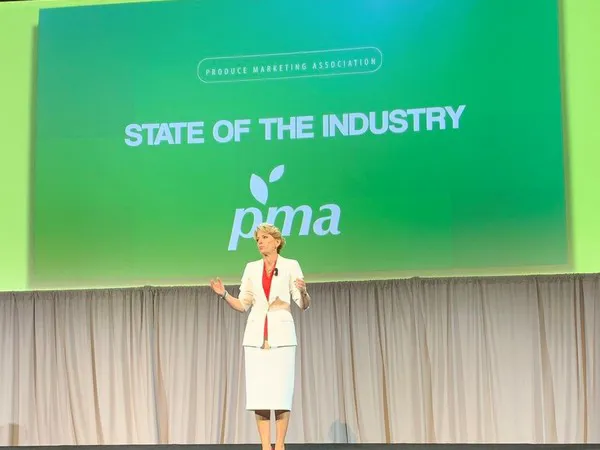The PMA Fresh Summit was held from October 17 through 19 in Anaheim this year. On October 17th, the event kicked off with a Forum for the Future, in which Cathy Burns, CEO of the PMA, gave her annual State of the Industry. During this talk, she discussed past, current, and projected trends in the marketing of fresh produce, as well as the developments that are being brought out by the PMA.

Food safety
The importance of food safety continues to be critical within the industry. When food is recalled, especially when it is recalled on such a mass scale as occurred last year with Romaine Lettuce in the U.S., consumer trust is damaged. Once consumer trust is damaged, it is difficult to build it back up. This is one of the reasons that the PMA has developed a food safety training platform certificate program, which teaches users the essentials of produce safety. Burns said: “It is critical to train employees not just on how to maintain high standards of food safety, but also why it is so critical. This program will make food safety training accessible to all employees. We, as an association, are maintaining an ongoing commitment to food and produce safety research, something which is critical to consumer trust and confidence.”
Frictionless consumer experience
One of the most important trends of today is the engagement of science and technology in both the production and the marketing of produce. “One year ago, technology was used to improve the consumer experience. This continues this year, but now the focus is on the logistics in store, and the goals is to create a frictionless consumer experience,” Burns said. Examples of this are in-store augmented reality apps, in-store cameras that automatically and continually take inventory and re-orders products so that the store will never be out of stock, and even in-home delivery services that deliver the products not just into your home, but also put the food away – and the consumer can watch through a camera that is pinned onto the delivery worker. Ford is even developing driverless cars with robots that deliver the packages, in cooperation with Agility Robotics. Burns stated: “Technology can transform consumer experience, but we are not innovating technology just for innovation’s sake. We are innovating in order to fix pain points for consumers.”
Sustainability
Another important focus is that of sustainability. Burns revealed: “72% of consumers expect socially responsible practices from grocery stores. Consumers are increasingly looking toward sustainable practices and products. The United States organic market in 2018 broke records with over $50 billion in sales – with millennials being the biggest consumers of organic foods. The plant-based food industry is also continuing to grow at a rapid pace. It is currently a $19.5 billion industry, and is projected to grow to $21 billion by 2025.”
Consumer Trends
About the consumer, Burns said: “Brands are successful when they are trustworthy, credible, and authentic. These are the characteristics that are important to consumers. There are new attitudes permeating the social consciousness. One of these is that health is the new wealth. Health has become a social currency and status is doled out based on the extent to which an individual’s lifestyle is healthy. While technology continues to grow and continues to become increasingly pervasive in our lives, ‘disconnecting’ has become an important trend as well. FOMO is turning into JOMO – the joy of missing out, de-stressing through disconnecting from the eternal buzz of the internet and social media.”
While disconnecting has become a growing movement, the importance of social media as a marketing tool has only grown. Burns revealed: “In 2018, there were 273 million Instagram posts with #food, and in 2019 this grew to 359 million posts. The social media influencers have had, and continue to have, an invaluable impact on the promoting of products. Nevertheless, no matter how successful influencers and sponsors are, the human connection will remain extremely important. The value of community is pervasive in every culture, and companies that exude this value often have better market access than companies that don’t.”
Understanding contemporary lifestyle trends has always been the key to marketing. “Another aspect that has always been important are the emotions of the consumer. We must connect with the consumer’s emotions if we want to really impact them personally and impact their purchasing habits and patterns. We need to help them understand how produce can benefit them and fit into their lives. We need to help them see the value of our product. We need to do all of this, but most importantly we need to continue to ask ourselves: How do we as an industry can be of profound use to consumers?” Burns concluded.
